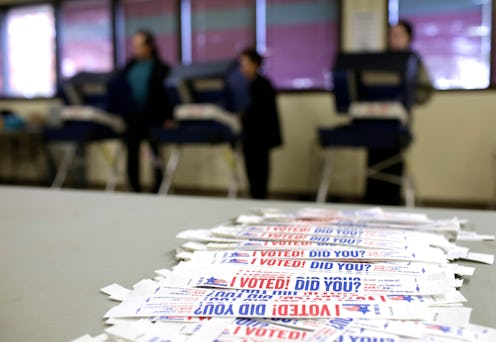News
Here's How Many Millennials Voted In The Election
Similar to how Barack Obama excited young people during both of his runs, Bernie Sanders triggered an astonishing level of enthusiasm among the under-30 demographic during the Democratic primaries. While initially reluctant to throw their support behind Hillary Clinton, the majority of Sanders supporters eventually gave in; however, it looks like enthusiasm dropped sufficiently after the primaries were said and done. In total, about 24 million millennials voted in the 2016 election. According to NPR's Asma Khalid, turnout among those voters under 29 can't be determined until the most recent census data is released. And while Clinton still won a majority of millennial votes, it wasn't enough to secure a victory.
During an interview with NPR's Audie Cornish, Khalid explained that voter turnout among millennials should have increased. However, based on the numbers thus far, it's unlikely that turnout among that demographic was larger than in 2012. She uses the state of Arizona as an example:
But we saw in a number of battleground states that the millennial share actually decrease — the millennial share of the electorate — from 2016 to 2012. And in a state like Arizona, that was key. You saw the millennial share drop from 26 percent down to 15 percent this year, meaning that probably not as many of them showed up.
Approximately 22 million to 23 million people between the ages 18 to 29 voted in the 2012 election, just slightly higher than, but almost the same as the numbers from the 2008 election, which attracted approximately 50 percent of all millennials. Obama easily scored the highest final share of these young voters on both occasions.
In October, a poll by USA Today and Rock the Vote estimated that approximately 83 percent of millennials were registered to vote across the country. While enthusiasm dropped after Sanders' defeat in the primaries, it was expected that the majority of these voters would pull through on Nov. 8. However, based on the numbers thus far, that doesn't seem to have been the case.
Trump will have to work hard over the next four years to court this demographic for the next election in 2020. In order to truly win this group over, Trump will have to make progress on tackling climate change, fight for equal rights, and, of course, figure out a way to make college more affordable. Considering Trump's past claims that climate change is a hoax, and his discriminatory and misogynistic comments, he has a lot of damage to undo.
